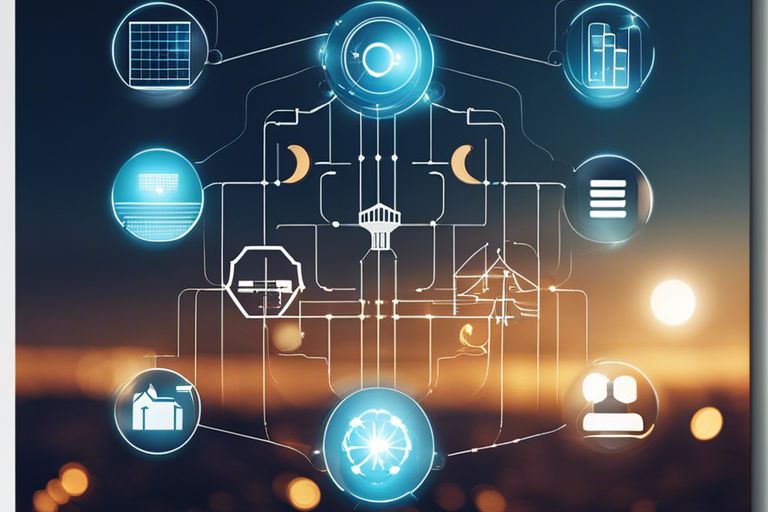It’s fascinating to contemplate how Internet of Things (IoT) technology can completely transform the way smart grid systems operate in the energy sector. By integrating sensors, meters, and communication devices, IoT enables unprecedented control and monitoring capabilities, increasing efficiency and reliability while reducing operational costs. This advancement paves the way for real-time data analysis, predictive maintenance, and energy optimization. However, with these advancements come challenges such as cybersecurity vulnerabilities that must be carefully addressed to ensure the seamless integration of IoT into our future smart grids.

IoT Integration in the Energy Sector
Enhancing Grid Intelligence
While the traditional grid system operates on a one-way communication flow, the integration of IoT in the energy sector introduces bidirectional communication capabilities, enabling smart devices to communicate with the grid. This enhances grid intelligence by allowing for real-time monitoring and analysis of energy consumption patterns, grid performance, and potential issues.
Real-Time Data Management
The integration of IoT technology in the energy sector revolutionizes real-time data management by enabling the collection, processing, and analysis of vast amounts of data from various grid devices and sensors. This real-time data management allows for immediate identification of inefficiencies, predictive maintenance, and quick response to potential grid disruptions.
Enhancing real-time data management in smart grid systems not only improves operational efficiency but also enhances grid reliability and resilience. By leveraging IoT technology to optimize energy distribution and consumption, utilities can reduce waste, lower costs, and improve overall grid performance.

The Benefits of IoT-Enabled Smart Grids
Clearly, the integration of Internet of Things (IoT) technology into smart grid systems has the potential to revolutionize the energy sector. IoT offers a wide range of benefits that can enhance the efficiency and effectiveness of smart grids, ultimately leading to a more sustainable and reliable energy infrastructure. To explore deeper into how IoT is transforming the energy industry, check out How IoT Is Transforming the Energy Industry.
Improved Energy Efficiency
On the frontline of benefits is the improved energy efficiency that IoT-enabled smart grids bring. By utilizing real-time data and advanced analytics, smart grids can optimize energy distribution, reduce wastage, and identify areas for improvement. This not only leads to significant cost savings for both energy providers and consumers but also contributes to a reduction in carbon emissions and overall environmental impact.
Accelerating Renewable Energy Adoption
Smart grid systems powered by IoT play a crucial role in accelerating the adoption of renewable energy sources. It enables better integration and management of decentralized renewable energy generation, such as solar panels and wind turbines, into the grid. With real-time monitoring and control capabilities, IoT enables efficient balancing of supply and demand, thus ensuring grid stability even with fluctuating renewable energy inputs.
It also opens up opportunities for peer-to-peer energy trading among prosumers, allowing individuals and communities to actively participate in the energy market and contribute to a more sustainable energy ecosystem.
Challenges and Solutions
Security Concerns in IoT-Smart Grid Convergence
Many challenges arise when integrating Internet of Things (IoT) technologies into smart grid systems, particularly in terms of security. On the one hand, IoT devices can provide valuable data for optimizing energy distribution and consumption. However, these devices also pose a significant security risk as they create new entry points for cyber attacks on the grid infrastructure. Ensuring the security of data transmission and device authentication is crucial to prevent potential breaches that could disrupt energy services.
Addressing Technological and Regulatory Barriers
Security measures must be implemented to address the technological and regulatory barriers that hinder the seamless integration of IoT into smart grid systems. Encryption protocols, access controls, and regular security audits are vital to protect the integrity of data and ensure compliance with industry regulations. Collaborative efforts between technology developers, energy providers, and regulatory bodies are necessary to establish robust security frameworks that can mitigate potential risks.
Addressing technological and regulatory barriers is imperative to unlock the full potential of IoT in revolutionizing smart grid systems. By prioritizing security measures and fostering partnerships among key stakeholders, the energy sector can embrace the benefits of IoT while safeguarding critical infrastructure from cyber threats.
The Future Landscape of IoT and Smart Grids
Once again, the integration of Internet of Things (IoT) technology with smart grid systems is poised to revolutionize the energy sector. This transformation is explored in detail in the blog post titled Smart Grids IoT Revolution for Efficient Energy Generation and Distribution.
Innovations on the Horizon
Smart innovations on the horizon for IoT and smart grid systems include advanced sensors for real-time monitoring, predictive analytics for proactive maintenance, and automated controls for optimized energy distribution. These advancements will enhance efficiency, reliability, and sustainability in energy generation and distribution.
Potential Impact on Global Energy Dynamics
On a global scale, the integration of IoT into smart grids has the potential to revolutionize the energy sector by enabling better management of resources, reducing wastage, and facilitating renewable energy integration. This could lead to a more sustainable and environmentally friendly energy ecosystem worldwide.
Plus, by optimizing energy generation and distribution, IoT-enabled smart grids can reduce carbon emissions and combat climate change by promoting the adoption of cleaner energy sources and enhancing overall energy efficiency.
What are the potential benefits of using IoT in smart grid systems for the energy sector?
By integrating IoT power plant optimization steps into smart grid systems, the energy sector can benefit from improved efficiency, real-time monitoring, and predictive maintenance. This technology allows for better resource management, reduced downtime, and overall cost savings, making the transition to smart grids a smart choice for the energy industry.
Final Words
Taking this into account, it is evident that the IoT has the potential to revolutionize smart grid systems in the energy sector by enabling real-time monitoring, optimizing energy distribution, and enhancing grid resilience. With the ability to collect and analyze vast amounts of data, IoT technology can help utilities make informed decisions, improve efficiency, and reduce costs. By integrating smart devices and sensors, energy companies can create a more reliable and sustainable grid infrastructure that can meet the evolving needs of modern society. Embracing IoT in the energy sector holds the key to creating a smarter, greener, and more efficient future.
FAQ
Q: How can IoT revolutionize smart grid systems in the energy sector?
A: IoT technology can revolutionize smart grid systems by enabling real-time monitoring of energy consumption, facilitating predictive maintenance of infrastructure, and optimizing energy distribution for improved efficiency and cost savings.
Q: What are the key benefits of incorporating IoT into smart grid systems?
A: By integrating IoT into smart grids, utilities can enhance grid reliability, reduce outages through predictive analytics, promote renewable energy integration, and empower consumers to make informed decisions about their energy usage.
Q: How does IoT enable improved energy management in the smart grid?
A: IoT devices such as smart meters and sensors can collect data on energy usage patterns, grid performance, and environmental conditions, allowing utilities to analyze this information and adjust energy distribution in real-time for optimal efficiency.
Q: What role does data analytics play in leveraging IoT for smart grid systems?
A: Data analytics software can process the vast amount of data generated by IoT devices to identify trends, anomalies, and opportunities for energy optimization, enabling utilities to make data-driven decisions to improve grid performance and customer satisfaction.
Q: How can IoT contribute to the growth of renewable energy sources in smart grid systems?
A: By connecting renewable energy sources such as solar panels and wind turbines to IoT networks, utilities can monitor their output, integrate them into the grid more effectively, and balance supply and demand in real-time to maximize the use of clean energy resources.



